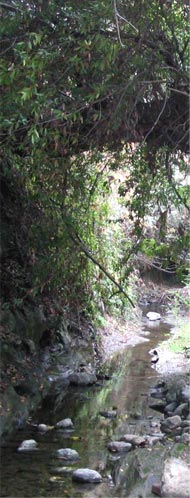

RIPARIAN WOODLAND AND CREEKS Riparian woodland is well established along Matadero and Deer creek and along the creeks of the San Francisquito watershed. There is also a substantial riparian forest associated with Searsville Reservoir. Vegetation along the creeks consists primarily of a moderately closed canopy of valley oak and coast live oak that ranges from approximately 20 to 40 feet in height. Associated species within this community include California buckeye, bay, redwood, willow, and alders. An understory shrub layer occurs beneath much of the riparian canopy, particularly in areas where gaps in the overstory allow direct sunlight. Shrub species present include poison oak, California rose, western leatherwood, common snowberry, blue elderberry, and coyote bush. The riparian forest associated with Searsville Reservoir is dominated by willows, maples, and dogwoods. Small clumps of native and non-native grasses and forbs are present in the understory of the riparian woodland, including ripgut brome, wild oat, horehound, poison hemlock, wild radish, field mustard, milk thistle, and California mugwort. Aquatic vegetation found intermittently along the creek channels includes water cress, iris-leaved juncus, broad-leaved cattail, and curly dock. Riparian woodlands provide abundant food, cover, and breeding habitat for wildlife. These factors, and the structural diversity of riparian woodland, are largely responsible for the high productivity of this habitat type. Bird species that are characteristic of this habitat at Stanford include California quail, mourning dove, orange-crowned warbler, Nuttall’s woodpecker, black phoebe, black-crowned night heron, belted kingfisher, western wood-pewee, California towhee, and song sparrow. Many of these species nest or roost in riparian woodlands and feed in adjacent habitat areas, such as annual grasslands. Stellar’s jay and western scrub jays are found in abundance in the riparian woodlands at Stanford, as are California thrasher, red-tailed hawk, Cooper’s hawk, red-shouldered hawk, and sharp-shinned hawk. Riparian woodlands also provide important feeding, resting, and nesting for neotropical songbirds such as warblers, vireos, grosbeaks, and flycatchers. Common mammals found within this riparian woodland include: deer, opossum, raccoon, deer mice, Botta’s pocket gopher, tree squirrels, San Francisco dusky-footed wood rat, California vole, coyote, gray fox, bobcat, striped skunk, and the non-native red fox. Merriam’s chipmunks are also occasionally encountered in the riparian woodlands at Stanford. Recent work by a Stanford graduate student indicates that the riparian areas at Stanford are used extensively by foraging bats. A number of bat species have been recorded including: Townsend’s big-eared bat, red bat, hoary bat, California myotis, Yuma myotis, and western pipistrelle. Amphibians and reptiles known to occur in this biotic community at Stanford include western toad, Pacific treefrog, California red-legged frog, arboreal salamander, black salamander, slender salamander, California newt, rough-skinned newt, Santa Cruz ensatina, California kingsnake, gopher snake, western night snake, western fence lizard, southern alligator lizard and western skink. Western pond turtles are found scattered throughout San Francisquito Creek. They have been reported from Matadero Creek by local residents, but have not been observed during recent surveys. Newts are common in the San Francisquito system, but they have not been observed in Stanford’s portion of the Matadero drainage during the recent surveys. Native fishes recorded from the Matadero and San Francisquito systems include three-spined stickleback, roach, Sacramento blackfish, Sacramento suckers, and sculpin. Steelhead/rainbow trout are abundant in the San Francisquito system, but have not been recorded in the Matadero system in recent surveys conducted by Stanford. Hitch are also present in the San Francisquito system. Native mussels, likely species of floaters, are found throughout the San Francisquito Creek system. Non-native aquatic animals that have been recorded from the creeks at Stanford include bullfrog, green sunfish, bluegill, red-ear sunfish, mosquito fish, largemouth bass, Louisiana red swamp crayfish, and signal crayfish. Bullfrogs are occasionally observed in the Stanford portions of Matadero Creek and Deer Creek; generally no more than three or four individuals are observed each year (and fewer than 10 bullfrog tadpoles have been encountered in Matadero and Deer creeks since the mid-1990s). Green sunfish are relatively common throughout the unincorporated Santa Clara County portion of Matadero Creek, but are limited in Deer Creek to reaches immediately upstream from its confluence with Matadero Creek (reaches that do not typically dry out). No young-of-the-year green sunfish have been observed in the Stanford portions of Matadero Creek and Deer Creek during annual surveys since 1997, suggesting that juvenile or adult sunfish may be dispersing into either downstream or upstream reaches. During recent annual surveys, only one largemouth bass was observed in the Stanford portion of the Matadero watershed, but Louisiana red swamp crayfish are frequently encountered. Mitten crabs, an invasive non-native crab, were first observed in the San Francisquito system in the late 1990s. In 1999 and 2000, hundreds of crabs were seen in San Francisquito Creek. Some individuals reach the confluence with Bear Creek. During 2001 through 2007, very few crabs were observed in the system, and there have been no observations of the crab within the past decade. Click here to view images of riparian woodland and creeks. |
& Real Estate
